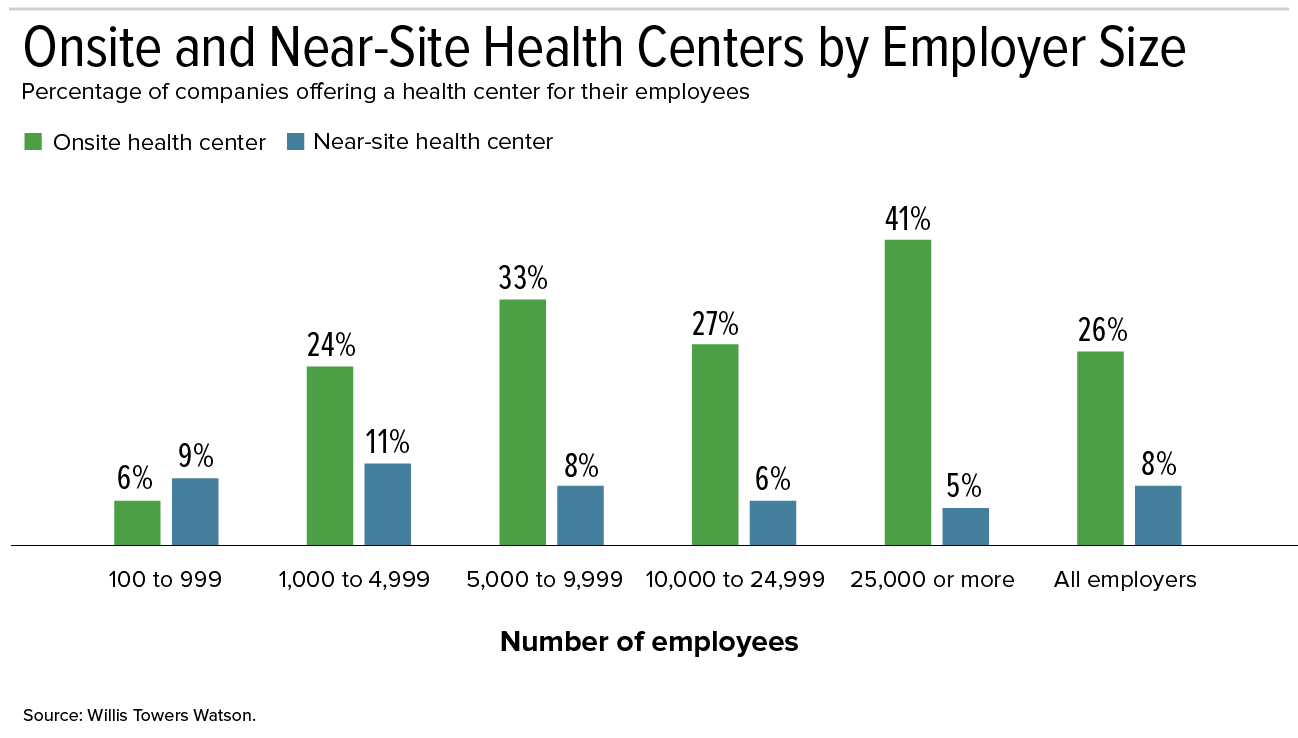The Pros, Cons and Possibilities of Onsite Health Care
Options range from telehealth kiosks to fully staffed clinics

Providing employees with onsite health care has helped large companies tamp down rising coverage costs while reducing employees' time off the job to visit doctors' offices. But small employers also have opportunities to offer employees access to onsite or nearby health care services.
Benefits of Onsite Health Care
Offering onsite health care can improve employees' health and well-being, said Ellen Kelsay, chief strategy officer at nonprofit National Business Group on Health (NBGH), an employers group in Washington, D.C.
For instance, she noted, because onsite care is convenient, it can improve employees' use of preventive screenings, immunizations and services that they might not otherwise get. If employees are receiving these recommended services, they're less likely to fall ill, to miss work or to make others at work sick.
Onsite medical services can also improve productivity because workers will spend less time away from their jobs visiting doctors, she noted.
According to the results of NBGH's members-only 2019 Large Employers' Health Care Strategy and Plan Design Survey, which reflects the health benefits offered by 170 big employers, medical staff most often available at onsite health centers are:
- Registered nurse—86 percent of onsite clinics.
- Physician assistant—63 percent.
- Doctor—60 percent.
- Nurse practitioner—34 percent.
- Physical therapist—23 percent.
"Many organizations have found that employer-based primary care clinics—such as onsite or near-site clinics—can check many must-have benefit boxes, while at the same time reducing the number of vendors needed" to otherwise provide these services, said Hannah Walker, Indianapolis-based total rewards director at OurHealth, which provides onsite clinics and wellness programs. She points to a long list of benefits that can be offered through an employer-sponsored clinic, such as:
- Wellness screenings.
- Health risk assessments.
- Chronic condition management.
- Employee health and wellness coaching.
Potential Pitfalls
For employers considering onsite or nearby health care services, the cost/benefit equation is likely top-of-mind. For employees, the top concern is privacy. At an onsite or near-site center, workers may fear that colleagues will see them visiting the clinic. Also, workers want to ensure that their medical records remain private.
Consequently, Kelsay says, "design really matters."
It might be ideal to put a clinic in an area that workers don't frequently visit. And using third-party health providers can ease employees' fears about employers having access to their medical information.
For smaller organizations, other potential pitfalls include the potential cost and administrative burden of managing an onsite clinic. According to research by Willis Towers Watson, based on a survey of 255 employers around the country with 100 to more than 25,000 employees, larger firms are still more likely to offer this benefit.

While larger employers have the resources to staff their own onsite health centers, this isn't the only option, Kelsay said. Even some very large employers choose to partner with their health plans to staff and build centers—whether on- or near-site. These types of partnerships, she said, represent most of the growth in these services.
[SHRM members-only toolkit: Managing Health Care Costs]
Options for Small and Midsize Companies
For smaller organizations, there are other options. Telehealth, for instance, is offering new and expanded opportunities for employers of all sizes to provide employees with convenient access to health care.
Amy McHugh, director of media relations at Blue Cross Blue Shield of Massachusetts in Boston, said the firm added telehealth kiosks to three of its main offices, providing 3,800 employees with options for onsite health care. "Instead of taking time off to go to the doctor, employees can use the kiosks during the workday to have a real-time video visit with a licensed provider who can diagnose, treat and prescribe medication for routine medical conditions such as sinus infections, sore throats, coughs, conjunctivitis, urinary tract infections and rashes," McHugh said. The kiosks include devices that patients can use to help medical professionals make a diagnosis, such as:
- Blood pressure cuffs.
- Thermometers.
- Pulse oximeters.
- Stethoscopes.
- Dermascopes.
- Otoscopes.
Small businesses looking to provide onsite or near-site care may also want to consider partnering with health insurers, local health care providers or other local businesses to help streamline and lower costs, Kelsay advised:
- Employers may be able to negotiate with their health insurer to handle administrative tasks associated with the clinic, possibly at a lower cost than using another third-party vendor. Health improvements derived from the clinic may also restrain increases in plan premiums.
- Partnering with other local businesses in a shared clinic could reduce expenses, and a local medical practice may be open to contracting for their doctors or other health professionals to work at the clinic part time.
Establish Goals
For employers considering some form of health services onsite or nearby, Kelsay recommends first establishing clear goals by asking "What is the organization hoping to address and how will success be measured?"
"You need to be realistic about the time horizon to see success," she said. "Value may not always be derived in terms of hard dollar savings, but more in terms of softer costs such as productivity or engagement."
Lin Grensing-Pophal is a freelance writer in Chippewa Falls, Wis.
Related SHRM Articles:
Onsite Health Clinics: What's the Effect on HDHPs and HSAs?, SHRM Online, November 2017
Fit for an Onsite Clinic, HR Magazine, January 2012
An organization run by AI is not a futuristic concept. Such technology is already a part of many workplaces and will continue to shape the labor market and HR. Here's how employers and employees can successfully manage generative AI and other AI-powered systems.



